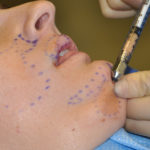
In the June 2018 issue of the journal Plastic and Reconstructive Surgery an article as published entitled ‘Supportive Use of Adipose-Derived Stem Cells in Cell-Assisted Lipotransfer for Localized Scleroderma’. In this clinical study abdominal fat samples were taken from eleven (11) linear scleroderma (on and not on corticosteroid therapy) and ten (10) normal liposuction patients and assessed for quantity, morphology and proliferation ability. Blood flow by laser contrast imaging was also done in scleroderma lesions and compared to those in the same patient on the opposite normal side. Special nude mice were also studied to evaluate the differences between lipotransfer and cell-assisted lipotransfer.
Their findings showed that the number of stem cells from scleroderma patients on steroids was reduced. Blood perfusion was not seen as different between scleroderma-involved tissues from that of normal tissues. In the special mice, lipotransfer and cell-assisted lipotransfer showed reduced TGF-beta and type III collagen expression.
Few studies have ever been done on scleroderma patients such as in this paper. The authors have made several insightful findings that can affect how we understand the role of fat grafting for linear scleroderma. The donor fat between normal and scleroderma patients is not different in number, shape or activity…unless the patient was on or had a history of corticosteroid therapy. This suggests that their adipocyte-derived stem cells may be more depleted and that stem cell-assisted fat grafting may improve treatment outcomes. Such a lipotransfer method also improved skin texture through reduced TGF-beta and type III collagen expression.
While this data is partially derived from animal studies it nonetheless provides a supportive approach to improved fat grafting outcomes in scleroderma patients.
Dr. Barry Eppley
Indianapolis Indiana


